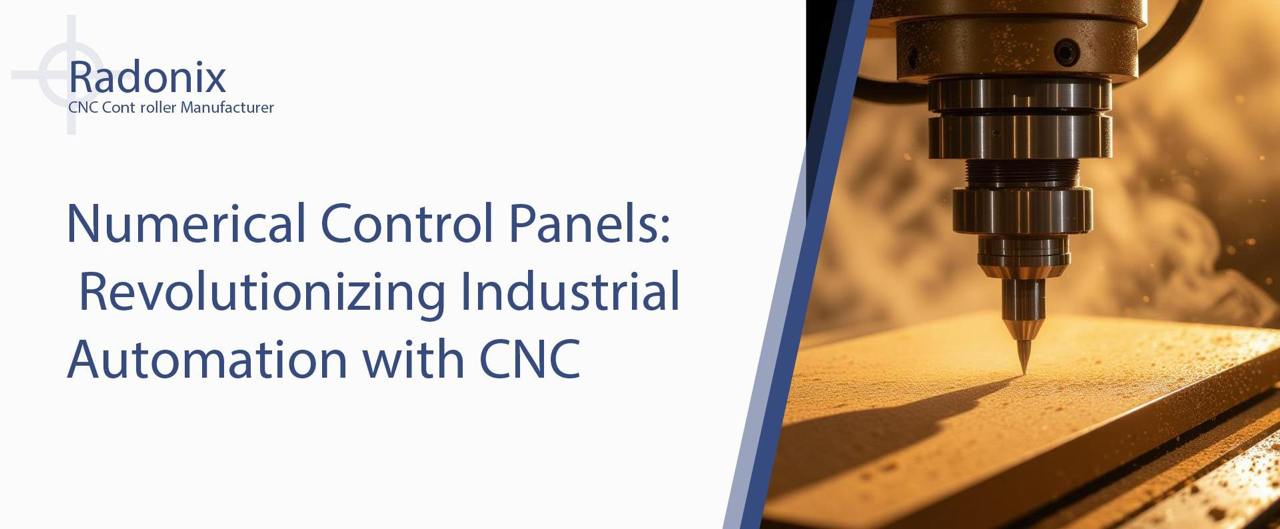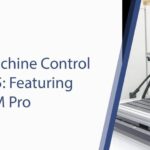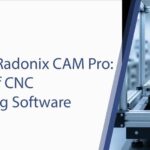The Evolution of Numerical Control Panels in CNC Technology
Numerical control panels have transformed from basic interfaces to sophisticated systems driving industrial automation. In the early days, these panels relied on punched tapes for input, limiting flexibility. Today, numerical control panels integrate digital touchscreens and AI for real-time control.
This evolution began in the 1950s with numerical control (NC) systems. By the 1970s, computer numerical control (CNC) emerged, incorporating microprocessors. Modern numerical control panels now feature wireless connectivity and cloud integration, enhancing CNC machine control unit performance.
Key advancements include multi-axis coordination and adaptive machining. These panels reduce setup times and improve accuracy in sectors like aerospace and automotive. CNC control panel functions have expanded to include predictive analytics, forecasting maintenance needs.
At radonix.com, we lead this evolution with innovative solutions. Our numerical control panels support seamless upgrades, ensuring longevity. As automation demands grow, these panels enable smarter factories, minimizing errors and maximizing output.
The shift to Industry 4.0 has made numerical control panels indispensable. They bridge design software with physical machines, streamlining workflows. Understanding this evolution helps manufacturers adopt technologies that boost competitiveness in precision environments.
Essential CNC Machine Control Unit Features for Automation
A CNC machine control unit powers automation by managing core operations. Essential features include high-speed processors for rapid code execution. These ensure smooth handling of complex programs without lags.
Axis interpolation is crucial. It coordinates multiple axes for precise movements, vital in 3D machining. Numerical control panels within the unit offer intuitive interfaces, simplifying operator inputs.
Safety integrations like emergency stops and sensor feedback prevent accidents. CNC control panel functions such as tool offset adjustments compensate for wear, maintaining accuracy.
Memory capacity stores extensive programs, supporting batch production. Connectivity options, including Ethernet and USB, facilitate data transfer from CAD systems.
- Real-time monitoring: Tracks spindle speeds and feeds.
- Error correction: Detects and alerts on anomalies.
- Customization: Allows macro programming for repetitive tasks.
These features automate workflows, reducing manual intervention. In industrial settings, a robust CNC machine control unit cuts costs by optimizing resource use. At radonix.com, our units emphasize durability and ease, ideal for demanding automation needs.
Numerical control panels enhance these by providing visual dashboards. Overall, selecting units with these essentials drives efficient, reliable automation in manufacturing.
Advanced CNC Control Panel Functions for Complex Operations
Advanced CNC control panel functions tackle intricate operations with precision. These include adaptive feed control, which adjusts speeds based on material resistance. This prevents tool breakage and improves surface finishes.
Simulation modes allow virtual runs, identifying issues before physical execution. Numerical control panels support this through graphical interfaces, displaying tool paths in 3D.
Probe integration enables in-process measurements. CNC control panel functions use this data for automatic corrections, ensuring tolerances in complex parts.
Multi-tasking capabilities run parallel processes, like simultaneous milling and drilling. Wireless diagnostics transmit data to remote systems for quick troubleshooting.
- Collision avoidance: Uses sensors to halt operations.
- Energy management: Optimizes power usage for sustainability.
- Data analytics: Logs metrics for process refinement.
These functions excel in high-mix, low-volume production. CNC machine control units with advanced panels reduce cycle times by up to 30%. Industries like medical device manufacturing rely on them for accuracy.
At radonix.com, our solutions incorporate these functions seamlessly. Mastering CNC control panel functions unlocks potential for complex, automated operations in modern factories.
Comparison of Numerical Control Panels from Leading Brands (Radonix CAM Pro, Mastercam, Fusion 360, SolidCAM)
Numerical control panels differ across brands, each with unique strengths. Radonix CAM Pro offers integrated panels with user-centric designs. Its advantages include fast setup and broad hardware compatibility, making it cost-effective for SMEs. CNC control panel functions here emphasize real-time edits and intuitive navigation, ideal for diverse applications.
Mastercam provides panels focused on high-end simulation. Advantages lie in detailed analytics and multi-axis support, suiting large-scale operations. However, it requires more expertise, potentially increasing training costs. Its numerical control panels excel in precision for aerospace parts.
Fusion 360 features cloud-enabled panels for collaboration. Key benefits include accessibility and automatic updates, lowering barriers for startups. It integrates well with design tools but may depend on internet stability. CNC machine control unit functions are strong in generative design.
SolidCAM’s panels integrate deeply with SolidWorks. Advantages include optimized toolpaths and iMachining for speed gains. It’s less versatile standalone but shines in CAD-heavy environments. Numerical control panels here prioritize efficiency in modeling transitions.
In comparison:
- Radonix CAM Pro: Best for affordability and integration.
- Mastercam: Superior for advanced simulations.
- Fusion 360: Excellent for team-based workflows.
- SolidCAM: Optimal for SolidWorks users.
Choosing depends on needs, with Radonix offering balanced, reliable options.
Pairing Numerical Control Panels with Radonix CAM Pro
Pairing numerical control panels with Radonix CAM Pro enhances automation efficiency. This software generates optimized G-code, which panels execute flawlessly. Start by connecting via compatible ports for direct data flow.
Benefits include streamlined workflows and reduced errors. Radonix CAM Pro supports 3D modeling, complementing CNC control panel functions like axis calibration.
At radonix.com, we provide free trials to test pairings. Fast downloads ensure quick implementation. Expert support guides setup, resolving issues promptly. Diverse integrations work with various machines, from routers to lathes.
This pairing unlocks advanced features, such as custom macros. Numerical control panels gain from software simulations, preventing costly mistakes.
Steps for pairing:
- Download Radonix CAM Pro from radonix.com.
- Install and link to your CNC machine control unit.
- Configure settings for specific operations.
- Run diagnostics to verify compatibility.
CNC control panel functions improve with this integration, offering better monitoring. For manufacturers, this combination drives precision and speed in industrial automation.
Encourage Radonix CAM Pro download for immediate benefits.
Best Practices for Implementing Numerical Control Panels
Implementing numerical control panels requires strategic planning. Begin with needs assessment. Evaluate your operations to match panel features with tasks.
Training is essential. Educate operators on CNC control panel functions to maximize utilization. Use simulations for hands-on practice without risks.
Regular maintenance ensures longevity. Clean interfaces and update firmware routinely. Monitor CNC machine control unit performance through logs.
Integrate gradually. Start with pilot projects to test compatibility. Scale up based on results.
- Backup data: Prevent loss during upgrades.
- Secure networks: Protect against cyber threats.
- Customize interfaces: Tailor for user efficiency.
Collaborate with experts for custom setups. At radonix.com, our resources aid implementation. Best practices reduce downtime and enhance ROI.
Numerical control panels thrive in optimized environments. Document procedures for consistency. Audit systems periodically for improvements.
By following these, manufacturers achieve seamless automation, boosting productivity in competitive markets.
Frequently Asked Questions About CNC Control Panel Functions
- What are key CNC control panel functions? They include program loading, axis jogging, and speed overrides for precise control.
- How do CNC control panel functions improve efficiency? By automating adjustments and providing real-time feedback, they cut production times.
- Can CNC control panel functions integrate with software? Yes, they pair with CAM tools for direct code transfer.
- What safety features are in CNC control panel functions? Emergency stops and limit alerts prevent mishaps.
- How to troubleshoot CNC control panel functions? Use diagnostic modes to identify and fix errors quickly.
- Is customization possible in CNC control panel functions? Many allow macro setups for tailored operations.
- What industries use CNC control panel functions? Manufacturing, woodworking, and metalworking benefit greatly.
- How does Radonix CAM Pro download enhance these functions? It provides optimized code for better performance.
In summary, numerical control panels are revolutionizing industrial automation through CNC technology. From evolution and essential features to advanced functions, brand comparisons, pairings, and best practices, this guide highlights their transformative role. Mastering CNC machine control units and CNC control panel functions leads to superior manufacturing outcomes.
Ready to advance your automation? Visit radonix.com for free trials, fast downloads, and expert support. Download Radonix CAM Pro today or contact us to integrate innovative solutions.








